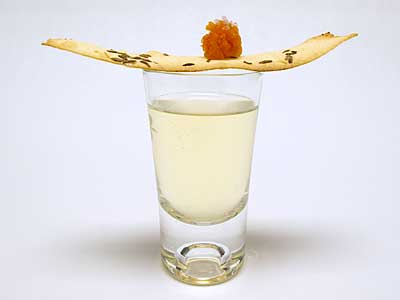May 30, 2011
Amuse-Bouche

essence de tomate
(tomato essence)
At the 2009 Oxford Symposium on Food and Cooking, Raymond Blanc of Le Manoir aux Quat’Saisons prepared the Saturday evening meal for the attendees. It was quite something: eating 4-star food sitting at the long tables of an Oxford University dining hall. The first course was a demi-tasse cup of a clear liquid. The liquid was slightly viscous and full of the flavor of tomatoes. The menu even included a recipe for the “soup.” In this case prepared from a huge amount of cherry tomatoes.
Since then, I’ve seen many recipes for the soup. Some called it a tomato essence and some a tomato consommé. All, including Blanc’s, consist of massive amounts of tomatoes, about 625 g (1-3⁄8 lb), per serving. But there’s more than just tomatoes. There’s some combination of onions, garlic, fennel, herbs, and spices in addition to the tomatoes. Most are cold preparations that involve draining the “essence” from the mixture through a cloth. A few even called for cooking everything and then using a classic egg-white mixture to clarify the soup.
My first attempt at making tomato essence came about without a plan and without a recipe. I had gone to my produce vendor to buy some plum tomatoes to use in a sauce preparation. But when I got there, I found the plum tomatoes substandard. Luckily, they had cluster tomatoes on sale for 69¢ a pound. I purchased about a third more by weight than I would have since these tomatoes tend to have less “meat” than the plum tomatoes for an equal weight.
As I was coring and seeding the tomatoes, I realized that I had a lot more liquid on my cutting board than I normally get with plum tomatoes. So, being a normal person, I scraped all the liquid and seeds in a bowl as I was prepping the tomatoes for my sauce.
I first used a medium-fine strainer and rubber spatula to separate the liquid from the seeds. This left me with a partially clear liquid with lots of red particles floating in it. I transferred the cloudy liquid to a coffee filter in a funnel and placed the whole assembly in my refrigerator. By the next day I had a glass of clear tomato essence. Unlike all the other recipes, all my tomato essence needed was a small pinch of fine salt. The flavor of this pure liquid was truly tomato and truly amazing.
Since that first straining, I’ve made tomato essence a number of times. It doesn’t matter whether I use red or yellow tomatoes, the final liquid is still clear and colorless. And it really doesn’t matter what type of tomatoes I use. Now, whenever I core and seed tomatoes for other purposes, I save the liquid. Once strained and filtered, the tomato essence seems to last a long time in the refrigerator.
For an amuse-bouche, rather than serve the essence plain, I decided a little garnish would be nice. In the picture, it’s being served with homemade sesame crackers and a little finely diced semi-dried tomato seasoned with a few grains of fleur de sel. I find that guests usually eat the cracker and diced tomato first in one bite, and then drink the tomato essence as a chaser. The crackers evolved from Clotilde Dusoulier’s recipe for crackers à l’huile d’olive et aux graines on her blog, Chocolate & Zucchini. The semi-dried tomato is from the tomates secs recipe on this website.
© 2011 Peter Hertzmann. All rights reserved.
